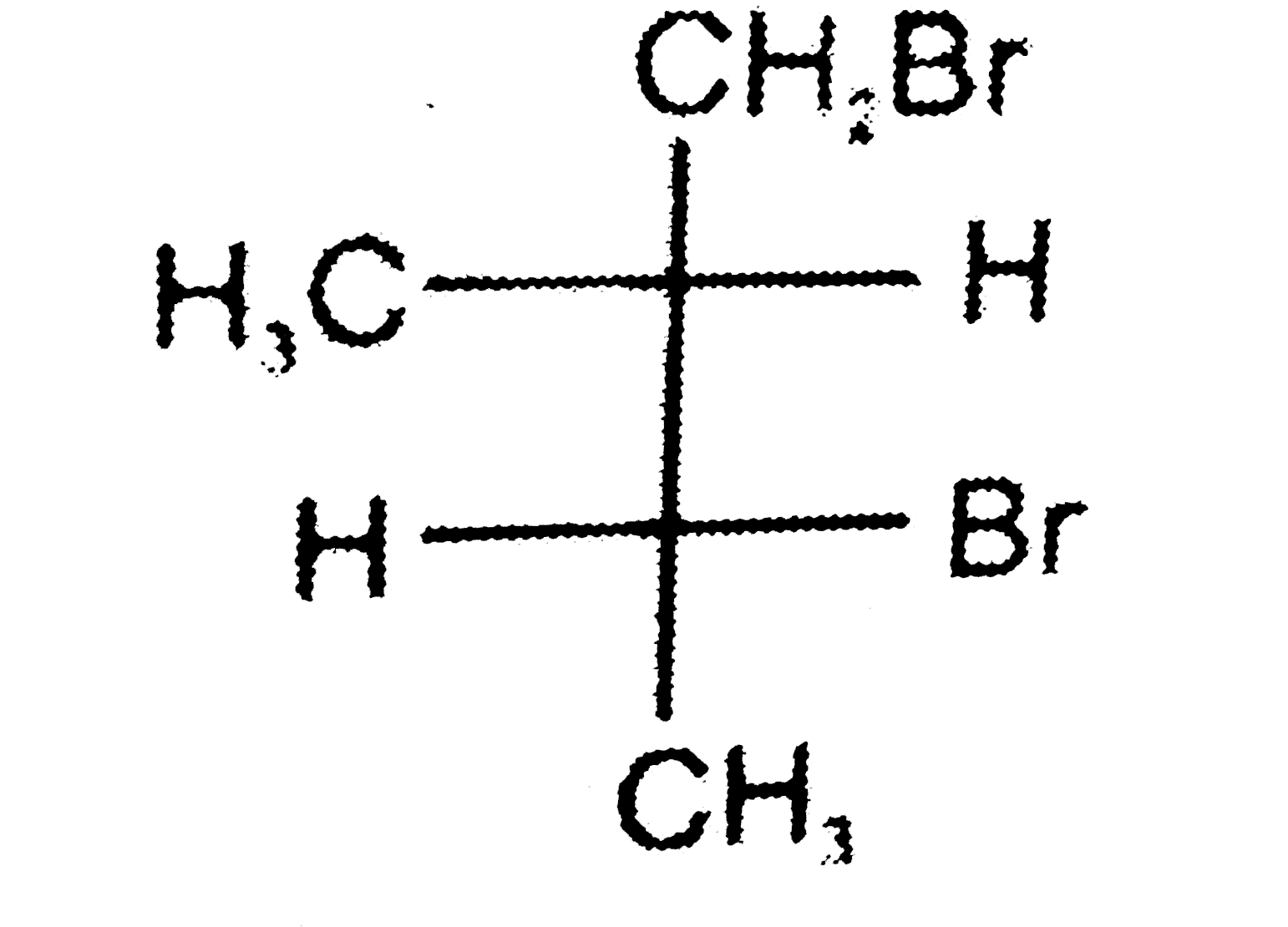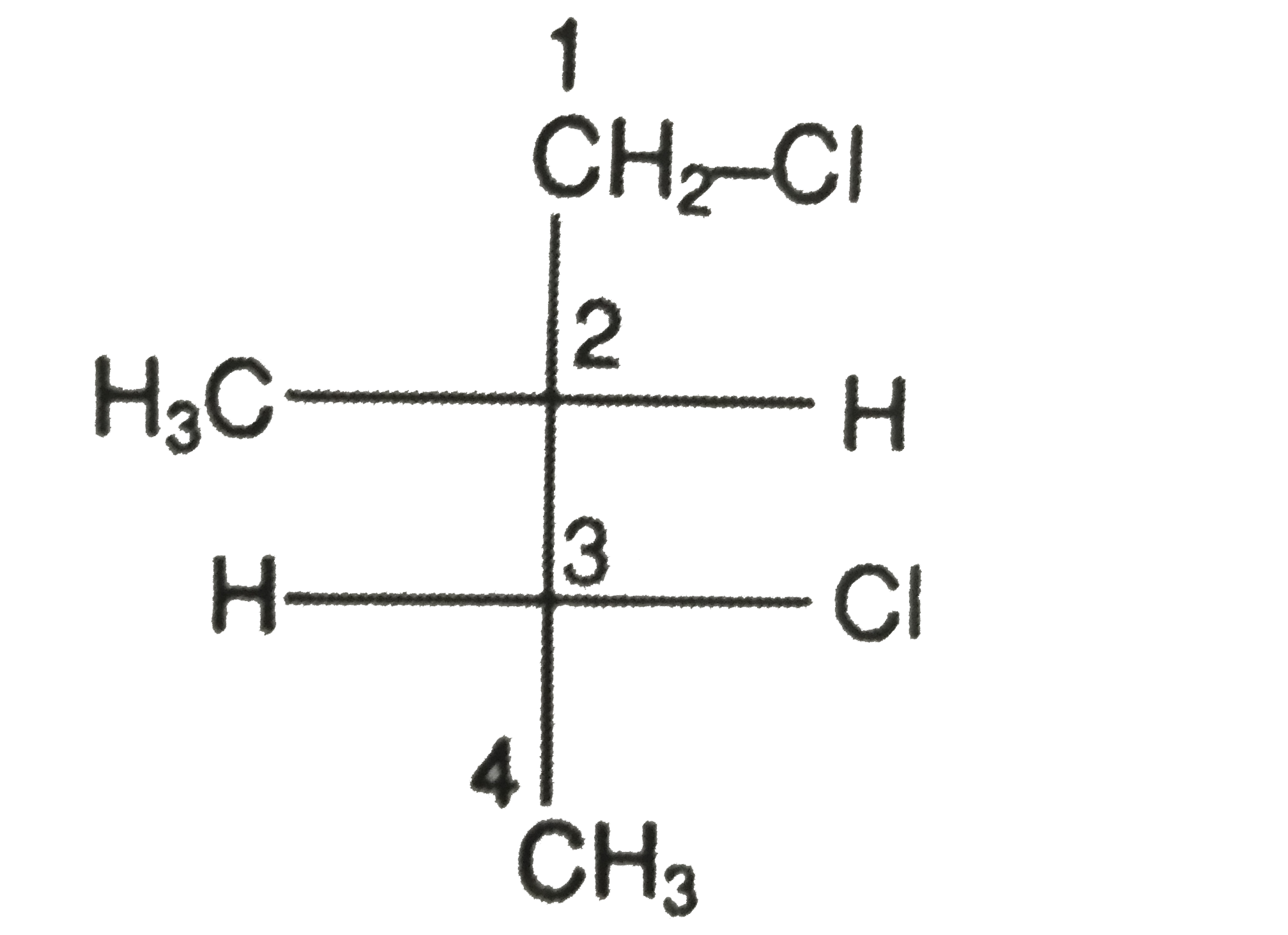The relative reactivity of 1∘,2∘ and 3∘ hybrogen's towards chlorination is 1:3.8:5. Calculate the percentages of all monochlorinated products obtained from 2-methylbutane.
To solve the problem of calculating the percentages of all monochlorinated products obtained from 2-methylbutane, we will follow these steps:
Step 1: Draw the Structure of 2-Methylbutane
2-methylbutane has the following structure:
CH3∣CH3−CH−CH2−CH3
In this structure, we have:
- 9 primary (1°) hydrogens (from the three CH3 groups),
- 2 secondary (2°) hydrogens (from the CH group),
- 1 tertiary (3°) hydrogen (from the CH group).
Step 2: Identify the Number of Each Type of Hydrogen
- 1° Hydrogens: 9 (from 3 CH3 groups)
- 2° Hydrogens: 2 (from the CH group)
- 3° Hydrogens: 1 (from the CH group)
Step 3: Write the Relative Reactivity Ratios
The relative reactivity of 1°, 2°, and 3° hydrogens towards chlorination is given as:
- 1° : 2° : 3° = 1 : 3.8 : 5
Step 4: Calculate the Relative Amount of Each Type of Chlorinated Product
Using the number of hydrogens and their reactivity ratios:
- For 1° hydrogens:
\(
\text{Relative amount} = 9 \times 1 = 9
\)
- For 2° hydrogens:
\(
\text{Relative amount} = 2 \times 3.8 = 7.6
\)
- For 3° hydrogens:
\(
\text{Relative amount} = 1 \times 5 = 5
\)
Step 5: Calculate the Total Relative Amount
Now, we sum up the relative amounts:
\(
\text{Total} = 9 + 7.6 + 5 = 21.6
\)
Step 6: Calculate the Percentages of Each Monochlorinated Product
Now we can calculate the percentage of each type of chlorinated product:
- Percentage of 1° chlorinated product:
\(
\text{Percentage} = \left( \frac{9}{21.6} \right) \times 100 \approx 41.67\%
\)
- Percentage of 2° chlorinated product:
\(
\text{Percentage} = \left( \frac{7.6}{21.6} \right) \times 100 \approx 35.19\%
\)
- Percentage of 3° chlorinated product:
\(
\text{Percentage} = \left( \frac{5}{21.6} \right) \times 100 \approx 23.15\%
\)
Final Results
- 1° chlorinated product: 41.67%
- 2° chlorinated product: 35.19%
- 3° chlorinated product: 23.15%
2-methylbutane has the following structure:
- 9 primary (1°) hydrogens (from the three CH3 groups),
- 2 secondary (2°) hydrogens (from the CH group),
- 1 tertiary (3°) hydrogen (from the CH group).
- 1° Hydrogens: 9 (from 3 CH3 groups)
- 2° Hydrogens: 2 (from the CH group)
- 3° Hydrogens: 1 (from the CH group)
The relative reactivity of 1°, 2°, and 3° hydrogens towards chlorination is given as:
- 1° : 2° : 3° = 1 : 3.8 : 5
Using the number of hydrogens and their reactivity ratios:
- For 1° hydrogens:
\(
\text{Relative amount} = 9 \times 1 = 9
\)
- For 2° hydrogens:
\(
\text{Relative amount} = 2 \times 3.8 = 7.6
\)
- For 3° hydrogens:
\(
\text{Relative amount} = 1 \times 5 = 5
\)
Now, we sum up the relative amounts:
\(
\text{Total} = 9 + 7.6 + 5 = 21.6
\)
Now we can calculate the percentage of each type of chlorinated product:
- Percentage of 1° chlorinated product:
\(
\text{Percentage} = \left( \frac{9}{21.6} \right) \times 100 \approx 41.67\%
\)
- Percentage of 2° chlorinated product:
\(
\text{Percentage} = \left( \frac{7.6}{21.6} \right) \times 100 \approx 35.19\%
\)
- Percentage of 3° chlorinated product:
\(
\text{Percentage} = \left( \frac{5}{21.6} \right) \times 100 \approx 23.15\%
\)
- 1° chlorinated product: 41.67%
- 2° chlorinated product: 35.19%
- 3° chlorinated product: 23.15%
Topper's Solved these Questions
- BOOK - NCERT EXEMPLAR ENGLISHCHAPTER - HYDROCARBONSEXERCISE - Matching The Columns4videos
HYDROCARBONS
- BOOK - NCERT EXEMPLAR ENGLISHCHAPTER - HYDROCARBONSEXERCISE - Assertion and Reason4videos
HYDROCARBONS
- BOOK - NCERT EXEMPLAR ENGLISHCHAPTER - HYDROCARBONSEXERCISE - Multiple Choice Questions (More Than One Options)9videos
HYDROCARBONS
- BOOK - NCERT EXEMPLAR ENGLISHCHAPTER - ENVIRONMENTAL CHEMISTRYEXERCISE - Long Answer Type5videos
ENVIRONMENTAL CHEMISTRY
- BOOK - NCERT EXEMPLAR ENGLISHCHAPTER - HYDROGENEXERCISE - LONG ANSWER TYPE QUESTIONS8videos
HYDROGEN
Similar Questions
The relative reactivity of 1∘,2∘and3∘ hydrogenes in clorination reaction has been found to be 1:3.8:5. In the reaction,

The ratio of the amount of the product (A), (B), (C) and (D) are expected to be :View SolutionThe relative reactivity of 1∘H,2∘Hand3∘H in bromiantion reaction has been found to be 1:82:1600 respectively. In the reaction,

The percentage yield of (A) and (B) are expected to be :View SolutionThe best method to prepare 3-methylbutane-2-ol from 3-methylbut-1-ene is
View SolutionThe R/S designation for the following stereoisomers of 1,3-Dibromo-2-methylbutane is :
 View Solution
View SolutionThe relative reactivity of 1∘:2∘:3∘H's to brominate is 1:82:1600, respectively. In the reaction
CH3−CH3∣CHExcessCH3+Br2hv−−→CH3CH3∣C∣Br(A)CH3+CH3CH3∣C(B)HCH2Br
the percentage yield of the products (A) and (B) are expected to beView SolutionAn isomer of C5H12 gives total six isomeric products on monochlorination. Calculate the percentage yield of the primary monochloride which is chiral. Consider the following relative reactivity of C−H bonds for chlorination.
∣∣∣Degree of C−H1∘C−H2∘C−H3∘C−HRelative reactivity for chlorination (R R)135∣∣∣View SolutionThe R/S designation for the following stereoisomers of 1,3-dichloro-2-methylbutane is :
 View Solution
View SolutionState whether each of the following is true or false.
a. Photobromination of 2-methylpropane gives a mixture of 1-bromo-2-methylpropane gives a mixture of 1-bromo-2-methylpropane and 2-bromo-2-methylpropa ne in the ratio 9:1
b. The percentage of n-propyl chloride obtained in the chlorination of propane is about 56%.
c. The percentage of 1-chloro-2-methylpropane obtained in the chlorination of isobutane is about 64%.
d. The percentage of n-propyl bromide in the bromination of propane is 44% . The relative reactives of 3∘ , 2∘ and 1∘ H atoms are 1600:82:1 .View SolutionWrite all the monochlorination products of the followings-
(i) Cyclopentane , (ii) 1−2, DimethylcyclopentaneView Solutiona. A hydrocarbon contains all the three tyopes of H atoms, i.e., 1∘,2∘ , and 3∘ . The relative ratios of abstraction of …………………… H atoms are 5.0:3.8:1.0 .
c. The relative rate of abstraction of 3∘,2∘ , and 1∘ H atoms is maximum for ................... H atoms.
d. The relative rate of abstraction of 3∘,2∘ , and 1∘ H atoms is minimum for ................. H atoms.View Solution

